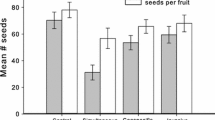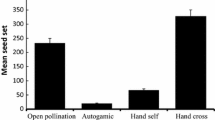Abstract
Sexual reproduction in Angiosperms mostly depends on pollen transfer mediated by an agent. In plants pollinated by biotic agents, reproductive success and population structure are mainly determined by pollinator behavior. To further comprehend this aspect of the reproductive process, data regarding pollen transport and deposition patterns need to be gathered and analyzed. The aim of this study was to examine pollen flow dynamics in a population of the Xylocopa bee-pollinated Passiflora caerulea using fluorescent powdered dyes as pollen mimics and to analyze the relationship between inter-plant distance and fruit production. Plant arrangement, number of flowers per plant, pollen flow and fruit set exhibited leptokurtic distributions as a function of the distance between plants. Minimum and maximum dispersal distances were 4 m and 257 m, respectively. Geitonogamous transfers were more frequent than xenogamous ones. Pollinator movements, evidenced by pollen analogues transferences, responded to plant arrangement. Centris sp. was recorded for the first time as a pollinator of Passiflora caerulea. Fruit set decayed as distance between individuals increased. The tools employed allowed to better understand the dependence between plant population structure, pollinator movement, pollen flow and fruit production, as well as to generate recommendations for crop spatial design of this promising and self-incompatible species, which will counteract the effects of harvesting from the wild.







Similar content being viewed by others
References
Alonso J, Desmarchelier C (2006) Plantas medicinales autóctonas de la Argentina, 1st edn. Fitociencia, Buenos Aires
Amela García MT (1999) Biología floral y sistema reproductivo de especies nativas de Passiflora (Passifloraceae) de la Argentina. PhD dissertation, Universidad de Buenos Aires, Argentina
Amela García MT, Hoc PS (1997) Floral biology and reproductive system of Passiflora caerulea (Passifloraceae). Beitr Biol Pflanzen 70:1–20
Amela García MT, Hoc PS (1998) Aspectos de la biología floral y el sistema reproductivo de Passiflora mooreana (Passifloraceae). Darwiniana 35:9–27
Amela García MT, Hoc PS (2012) Pollination mechanisms in Passiflora species: the common and the rare flowers—ecological aspects and implications for horticulture. In: Raskin ND, Vuturro PT (eds) Pollination: mechanisms, ecology and agricultural advances. Nova Science Publishers, New York, pp 33–55
Amela García MT, Hoc PS, Fernández MB (2013) Contenido palinológico de nidos de Xylocopa spp. (Antophoridae). Bol Soc Argent Bot 46(Supl):99.
Aquino DS (2014) Dispersión de polen en una población de Passiflora caerulea (Passifloraceae). Undergraduate thesis, Universidad de Buenos Aires, Argentina.
Baddeley A, Rubak E, Turner R (2015) Spatial point patterns: methodology and applications with R. Chapman and Hall/CRC Press, London. https://www.crcpress.com/Spatial-Point-Patterns-Methodology-and-Applications-with-R/Baddeley-Rubak-Turner/9781482210200/
Bivand R, Keitt T, Rowlingson B (2018) rgdal: bindings for the ‘geospatial’ data abstraction library. R package version 1.2-18. https://CRAN.R-project.org/package=rgdal
Christensen AB, Olensen JM (1998) Trap-line pollination and fruit fate in Passiflora vittifolia (Passifloraceae) in the Peruvian Amazonas. In: Christensen AB (ed) Passionflowers and their birds, bees and butterflies: the ecology and evolution of pollination and herbivory in Passiflora. Ph. D. Thesis. Univ. of Aarhus, Denmark
Deginani NB (2001) Las especies argentinas del género Passiflora (Passifloraceae). Darwiniana 39:43–129
Di Rienzo JA, Casanoves F, Balzarini MG, Gonzalez L, Tablada M, Robledo CW. InfoStat versión 2011. Grupo InfoStat, FCA, Universidad Nacional de Córdoba, Argentina. https://www.infostat.com.ar
Fraser DF, Gilliam JF, Daley MJ, Le AN, Skalski GT (2001) Explaining leptokurtic movement distributions: intrapopulation variation in boldness and exploration. Am Nat 158:124–135
Gachanja SP, Ochieng PO (1988) Effect of row spacing of purple passion fruit (Passiflora edulis forma edulis Sims) on fruit yield in Kenya. Acta Hort 218:1
Girón Vander-Huck M (1984) Biología floral de tres especies de Passiflora. Undergraduate thesis, Depart. of Biology, University of Antioquía, Antioquía, Colombia.
Goulson D (1999) Foraging strategies of insects for gathering nectar and pollen, and implications for plant ecology and evolution. Perspect Plant Ecol Evol Syst 2:185–209
Haddad García O (1968) Nuevos datos de rendimiento de parchita maracuya (Passiflora edulis forma flavicarpa) en diferentes densidades de siembra y alturas de espalderas. Agronomía Trop 18:387–392
Handel SN (1983) Pollination ecology, plant population structure, and gene flow. In: Real L (ed) Pollination biology. Academic Press, Orlando, pp 163–211
Harder LD, Barrett SCH (1996) Pollen dispersal and mating patterns in animal-pollinated plants. In: Lloyd DG, Barrett SCH (eds) Floral biology. Chapman & Hall, New York, NY, pp 140–190
Hijmans RJ (2017) raster: geographic data analysis and modeling. R package version 2.6-7. https://CRAN.R-project.org/package=raster
Hopkins B, Skellam JG (1954) A new method for determining the type of distribution of plant individuals. Ann Bot 18:213–227
Jakobsson A, Padrón B, Ågren J (2015) Distance-dependent effects of invasive Lupinus polyphyllus on pollination and reproductive success of two native herbs. Basic Appl Ecol 16(2):120–127
Janzen DH (1971) Euglossine bees as long-distance pollinators of tropical plants. Science 171:203–205
Kameyama Y, Isagi Y, Naito K, Nakagoshi N (2000) Microsatellite analysis of pollen flow in Rhododendron metternichii var. hondoense. Ecol Res 15(3):263–269.
Kearns CA, Inouye DW (1993) Techniques for pollination biologists. Univ, Press of Colorado, Colorado
Levin DA, Kerster HW (1969) Density-dependent gene dispersal in Liatris. Am Nat 103:61–74
Linsley EG (1978) Temporal patterns of flower visitation by solitary bees, with particular reference to the Southwestern United States. J Kansas Entomol Soc 51(4):531–546
May PG, Spears EE Jr (1988) Effect of defoliation on gender expression and fruit set in Passiflora incarnata. Am J Bot 75:1842–1847
Mayer C, Van Rossum F, Jacquemar AL (2012) Evaluating pollen flow indicators for an insect-pollinated plant species. Basic Appl Ecol 13:690–697
Mendiondo GM, Amela García MT (2006) Emergence of Passiflora caeruela seeds simulating possible natural destinies. Fruits 61:251–257
Mustajärvi K, Siikamäki P, Rytkönen S, Lammi A (2001) Consequences of plant population size and density for plant–pollinator interactions and plant performance. J Ecol 89(1):80–87
Nilsson LA, Rabakonandrianina E, Pettersson B (1992) Exact tracking of pollen transfer and mating in plants. Nature 360:666–668
Pasquet RS, Peltier A, Hufford MB, OudinE Saulnier J, Paul L, Gepts P (2008) Long-distance pollen flow assessment through evaluation of pollinator foraging range suggests transgene escape distances. Proc Natl Acad Sci USA 105(36):13456–13461
Peakall R, Beattie AJ (1991) Genetic consequences of worker ant pollination in a self-compatible, clonal orchid. Evolution 45:1837–1848
Pebesma EJ, Bivand RS (2005) Classes and methods for spatial data in R. R News 5 (2). https://cran.r-project.org/doc/Rnews/.
Pérez-Méndez N, Jordano P, Valido A (2018) Persisting in defaunated landscapes: reduced plant population connectivity after seed dispersal collapse. J Ecol 106(3):936–947
Price MV, Waser NM (1979) Pollen dispersal and optimal outcrossing in Delphinium nelsoni. Nature 277:294–296
R Development Core Team (2016) R: a language and environment for statistical computing. R Foundation for Statistical Computing, Vienna, Austria. ISBN 3-900051-07-0. https://www.R-project.org.
Ragonese AE, Martínez Crovetto R (1947) Plantas indígenas de la Argentina con frutos o semillas comestibles. Rev Investig Agríc 1:147–216
Richards AK (1986) Plant breeding systems. George Allen & Unwin, London
Rodríguez MA (2010) A modeling framework for assessing long-distance dispersal and loss of connectivity in stream fish. In: Community ecology of stream fishes: concepts, approaches, and techniques. American Fisheries Society, Symposium, vol 73, pp. 263–279.
Sakagami SF, Laroca S (1971) Observations on the bionomics of some neotropical Xylocopine bees, with comparative and biofaunistic notes (Hymenoptera, Anthoporidae). J Fac Sci 18(1):57–124
Sazima I, Sazima M (1989) Mamangavas e irapuás (Hymenoptera, Apoidea): visitas, interaçoes e consequencias para polinização do maracujá (Passifloraceae). Rvta Bras Entom 33:109–118
Schulke B, Waser NM (2001) Long-distance pollinator flights and pollen dispersal between populations of Delphinium nuttallianum. Oecologia 127(2):239–245
Thomson JD, Thomson BA (1989) Dispersal of Erythronium grandiflorum pollen by bumblebees: implications for gene flow and reproductive success. Evolution 43:657–661
Thomson JD, Price MV, Waser NM, Stratton DA (1986) Comparative studies of pollen and fluorescent dye transport by bumblebees visiting Erythronium grandiflorum. Oecologia 69:561–566
Tonsor SJ (1985) Leptokurtic pollen-flow, non-leptokurtic gene-flow in a wind-pollinated herb Plantago lanceolata L. Oecologia 67(3):442–446
Ulmer T, MacDougal JM (2004) Passiflora: passionflowers of the world. Timber Press, Cambridge
Van Rossum F (2009) Reproductive success and pollen dispersal in urban populations of an insect-pollinated hay-meadow herb. Perspect Plant Ecol Evol Syst 12:21–29
Van Rossum F, Triest L (2010) Pollen dispersal in an insect-pollinated wet meadow herb along an urban river. Landsc Urban Plan 95:201–208
Van Rossum F, Stiers F, Van Geert A, Triest L, Hardy OJ (2011) Fluorescent dye particles as pollen analogues for measuring pollen dispersal in an insect-pollinated forest herb. Oecologia 165:663–674
VanDerWal J, Falconi L, Januchowski S, Shoo L and Storlie C (2014) SDMTools: Species Distribution Modelling Tools: Tools for processing data associated with species distribution modelling exercises. R package version 1.1-221. https://CRAN.R-project.org/package=SDMTools
Waser NM (1988) Comparative pollen and dye transfer by pollinators of Delphinium nelsonii. Funct Ecol 2:41–48
Waser NM, Price MV (1982) A comparison of pollen and fluorescent dye carryover by natural pollinators of Ipomopsis aggregata (Polemoniaceae). Ecology 63:1168–1172
Waser NM, Price MV (1983) Optimal and actual outcrossing in plants, and the nature of plant-pollinator interaction. In: Jones CE, Little RJ (eds) Handbook of experimental pollination biology. S&AE, New York, pp 341–359
Wickham H, Hester J, Francois R (2017) readr: read rectangular text data. R package version 1.1.1. https://CRAN.R-project.org/package=readr
Zhang LJ, Lou AR (2018) Patterns of pollen dispersal in an invasive population of Solanum rostratum (Solanaceae) in China. Russ J Ecol 49(6):517–523
Acknowledgements
We thank Drs. G. Mendiondo and L. Strittmatter for sending the fluorescent powdered dyes, Dr. A. Carbajo for the assistance with the maps and data matrix confection, Dr. M. A. Ribichich for suggestions about some data treatment and Dr. J. Sanders for English reviewing and editing. We would also like to thank two anonymous reviewers for suggesting modifications and providing advice on improving our manuscript. This work was financed with Grant PIP IU 00185 from the CONICET (Consejo Nacional de Investigaciones Científicas y Técnicas).
Author information
Authors and Affiliations
Corresponding author
Ethics declarations
Conflict of interest
The authors declare that they have no conflict of interest.
Additional information
Communicated by Thomas Abeli.
Publisher's Note
Springer Nature remains neutral with regard to jurisdictional claims in published maps and institutional affiliations.
Rights and permissions
About this article
Cite this article
Aquino, D.S., Amela García, M.T. Pollen dispersal in a population of Passiflora caerulea: spatial components and ecological implications. Plant Ecol 220, 845–860 (2019). https://doi.org/10.1007/s11258-019-00958-5
Received:
Revised:
Accepted:
Published:
Issue Date:
DOI: https://doi.org/10.1007/s11258-019-00958-5




